By Brian Dunleavy
As a former intercollegiate athlete, Jennifer Stewart, OD, knows the right equipment often makes all the difference between winning and losing.In her case, Stewart, a track and field star at Marist College in Poughkeepsie, N.Y., that meant the running shoes that were lightweight, but provided the necessary support to keep her body healthy. Now, as an optometrist specializing in sports vision therapy—she co-founded Performance 20/20, a center offering vision evaluation and instruction for athletes, in Stamford, Conn., in 2016—the vital tools for success include not only spectacle and contact lenses designed with athletic performance and function in mind, but also the latest diagnostic technology and devices used to assist in “training” athletes’ vision to help them achieve their goals.
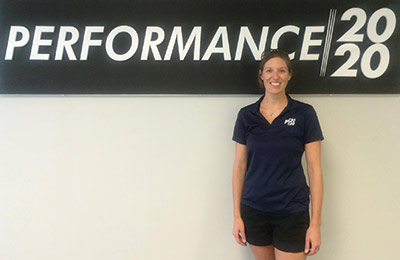
Sports vision specialist Dr. Jennifer Stewart
“I have always been an athlete and interested in sports,” says Stewart, who also has a separate four doctor routine optometry practice, called Norwalk Eye Care. “Sports and performance have always been and continue to be a large part of my life—I continue to compete in triathlons, cycling and trail races, while my husband is an elite triathlete—and I wanted to find a way to combine my love of sports and athletics with my day job. Sports and performance vision is a fantastic way to blend optometry and with helping athletes achieve their goals.”
Alex Andrich, OD, president of the International Sports Vision Association (ISVA), says that adding sports vision to his vision therapy practice in Cleveland, Ohio was a natural progression.
“Working with athletes of any age is practicing vision therapy at the highest level,” remarks Andrich, who is also a vision coach for the Cleveland Indians and Cleveland Monsters minor league hockey team. “Athletes, by nature, are ultracompetitive so being able to give them an opportunity to improve in their respective sports is very exciting.”
So what are some of the technologies sports vision therapists such as Stewart and Andrich use in their day-to-day practices?
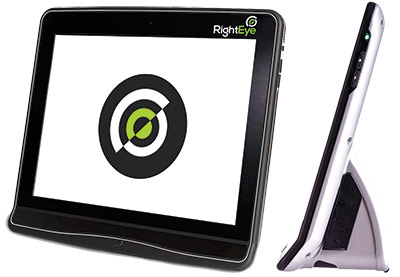
RightEye’s Sports Vision EyeQ is a non-invasive, objective test that measures and
analyzes an athlete’s eye movement, brain processing and reaction time
TESTING TOOLS
Vision training for athletes needs to start with an evaluation of their current needs. That includes assessment of their eye/hand coordination, reaction time and “anticipation”—their ability to essentially predict what will happen next on the field of play (think: where the ball will go so they can run it down and catch it) as well as decision-making and overall athletic performance.
“We don’t actually train the eyes; that’s a bit of the misnomer,” Stewart notes. “We teach athletes to identify faster, make a cognitive decision faster and therefore make a faster and more efficient motor decision. For any sport, this is essential, including hitting a fastball, making a save in goal or catching a pass. Athletes understand anticipation and decision making—we explain our training in context of their sport and position.”
Among the technologies available for this evaluation stage is RightEye’s Sports Vision EyeQ. According to the company, which specializes in eye-tracking technology, EyeQ is a non-invasive, objective test that measures and analyzes an athlete’s eye movement, brain processing and reaction time. Notably, it also maintains a database of test results so athletes can compare their vision performance with that of their peers, including amateurs and pros. In fact, the company has formal partnerships with Major League Baseball and USA Baseball, among other organizations.
However, the EyeQ’s contribution to the training process doesn’t stop with the assessment. Indeed, the system produces a report of an athlete’s results on the platform and then designs a customized “game plan” designed to improve performance, using RightEye’s Sports Vision Trainer, which includes a video library of more than 150 sport-specific videos they can complete at home or at the gym.
Similarly, the Edge Trainer from Vizual Edge, a company that has focused on web-based visual performance assessment platforms for the past 15 years, is designed to assess athletes’ “visual processing” strengths and weaknesses—essentially, how they see, process what they see and act upon it—and then design an individual program to improve their reaction time, positional and spatial awareness and recognition; or as the company puts it, “to sharpen neural pathways between the eyes and brain, enhancing an athlete’s ability to optimize performance.”
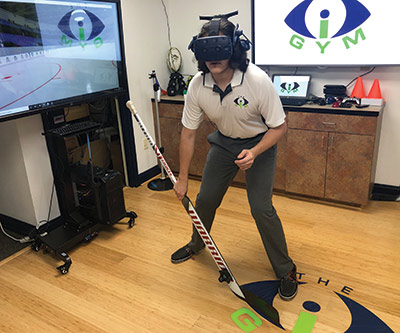
Visucog’s A.M.P. Training System enables vision therapists to build multisensory stimuli in virtual reality and real-world environments tailored to a patient’s visual neurocognitive training needs
The analysis is done based on the company’s six core visual skills: convergence (or the coordinated inward movement of both eyes toward each other in order to view a target at close range), depth perception (or the ability to perceive the relative distance of a target as well as its velocity and trajectory), divergence (or the simultaneous outward movement of both eyes away from each other to locate a target at distance), recognition (the ability to observe, process and recall a series of visual targets and respond), vision tracking (the ability to maintain focus on a target while monitoring all other aspects of the game) and visual alignment (the ability to perceive the true location of a target—like a ball in the air—as opposed to the space in front of or behind it).
The Edge Trainer’s programs are “organic,” meaning they evolve to become more challenging as the athlete’s skills progress and improve. Some of the programs are for the enhancement of overall performance, while others focus on specific skills athletes may want to “hone” immediately prior to a competition. Vizual Edge offers customizable training programs for a variety of sports and the various positions athletes in these sports play. The Edge Trainer has been used by the baseball program at Northern Illinois University and by teams in the United States Hockey League.
Cognivue Advanced, a risk assessment test originally developed to identify changes in cognitive function that may be early signs of dementia or Alzheimer’s disease, is a computerized platform with vision health components that can be used by eyecare professionals engaged in many types of specialty care, including sports vision. The 10 minute test assesses visuo-motor aptitude—essentially the ability to see stimuli and respond—as well as a patient’s ability to see and distinguish between different shapes. The platform also evaluates “visual memory,” or patients’ ability to remember what they see.
“Diagnostic technologies can identify opportunities to help an athlete based on their unique vision profile,” explains Bronson Hamada, OD, owner of Surf City Optometry in Huntington Beach, Calif. “Vision and sensory skills that are germane to sport performance are tested and compared with normative data. This data can be advantageous in helping pinpoint specific areas to train, but I caution not to rely so heavily on diagnostic technology that you forget about holistically evaluating the athlete standing in front of you. Oftentimes I am not concerned how an athlete compares with other athletes. I am more concerned that they have improved and that they have gained confidence in their visual abilities.”
Indeed, these diagnostics are really where the rubber meets the road for eyecare professionals practicing sports vision therapy. Stewart, in fact, sees it as a natural extension of a conventional eye exam.
“We help athletes improve eye-hand coordination, reaction, anticipation, timing, decision-making and overall athletic performance, and develop individualized training plans for each athlete, and work with them on their specific needs, goals and areas of opportunities,” Stewart adds. “Each athlete has a comprehensive baseline evaluation that we use to develop their profile and training program.”
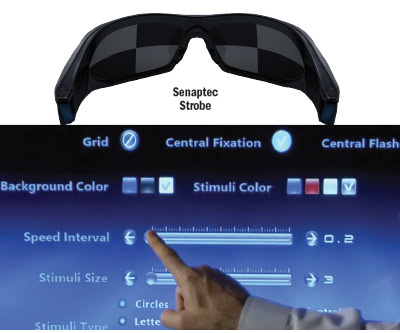
Sanet Vision Integrator from HTS has a touch screen monitor and is designed to enhance visual skills such as fixation
stability, eye-hand coordination, visual reaction time, speed and span of recognition and contrast sensitivity, among others
PLAYING THE FIELD
Once athletes have had their visual strengths and weaknesses assessed, optometrists practicing sports vision therapy have a number of options available to assist their patients in improving and honing their visual skills.
Stroboscopic training is one example, and it’s designed to help enhance sensory skills. The Senaptec Strobe is a stroboscopic training platform that uses specialized eyewear equipped with liquid crystal technology to strengthen “the connections between” an athlete’s eyes, brain and bodyis. The Strobe is Senaptec’s specialty product, and it has been used by athletes, as well as military and law enforcement agencies. The eyewear that is integral to platform features lenses that flicker between clear and opaque. When opaque, the lenses effectively remove visual information from the wearer’s view, forcing them to process what they still see more efficiently. In addition to the Strobe, the company also makes the Sensory Station, a sensory evaluation and training platform that assesses 10 visual and sensorimotor skills in less than 25 minutes, allowing therapists and their sports clients to quickly identify opportunities to improve sensory performance. It includes automated data collection, analysis and immediate reporting. Rickelle Pimentel, a member of the U.S. national shooting team, is a Senaptec user.
Vima Rev is another stroboscopic vision training platform that can be used in sports vision therapy. Vima, which has many current and former athletes on staff, has developed specialized eyewear designed to provide “resistance training” for the brain. When the lenses “strobe,” according to the company, they “take away” varying amounts of visual information, forcing an athlete to be more efficient with their decision-making on the field of play and “keep their eyes on the ball.” In general, several studies have demonstrated that strobe training can improve skills such as reaction time, depth perception and focus.
Another platform designed to improve reflexes, reaction time and focus is the NeuroTracker, a company with roots in the eyecare field. Developed by Canadian optometrist Jocelyn Faubert, OD, who is a professor at the University of Montreal and a member of its Biomedical Engineering institute and Institute for Neurosciences Research, the NeuroTracker software can be used on a computer or a portable device. A typical exercise starts with seven stationary brightly colored balls on a dark background. Four of the balls turn red for a second before returning to their original color. Then, all seven begin moving rapidly, bouncing around on the screen. The athlete’s task? Maintain focus on the balls that briefly turned red.
According to the company, the technology has been used by the Atlanta Falcons of the NFL, Manchester United of the English Premier League, MLB’s Oakland A’s and the NHL’s Vancouver Canucks, among others. Several top professional athletes have said that they not only use it to routinely “exercise” their eyes, but also as part of a pregame ritual to boost focus.
The Edge from Reflexion is another “screen-based” technology, developed by a company made up of current and former athletes who have direct experience with post-concussion syndrome and its effects on vision. The manufacturer, which specializes in vision training for athletes, bills the Edge as “a gamified neuro-fitness platform” designed to improve eye-hand coordination and reaction time, among other metrics. The system comes with a 6 foot by 2 foot LED touch screen that can be mounted on a wall or with a tripod stand. In one of its “games,” called “Minefield,” athletes stand in front of the screen, and for 30 seconds, they attempt to spot and respond to flashing lights of varying colors. Though the LED screen is large, it is also lightweight, meaning it can travel with athletes and teams, wherever competition takes them.
Other options available to sports vision therapists—and their patients—include software-based platforms designed to support comprehensive sports vision therapy regimens. Binovi by EyeCarrot, a company that specializes in diagnostics and therapeutic platforms for a number of vision conditions, is actually a series of technologies for use in various facets of the management of sports vision patients. The “control center,” to use the manufacturer’s term, is the Binovi Pro, a software hub that allows sports vision therapists and other professionals to oversee all of their individual patient’s vision training regimens, monitor their progress and plan training regimens.
The athletes, meanwhile, can use the training platform, Binovi Touch. Essentially, the Binovi Touch has modified an old sports vision therapy approach—the Wayne Saccadic Fixator—for use with a handheld device, like a tablet. Using the Wayne Saccadic Fixator, athletes can work with a series of “modules” developed to improve balance, movement, reaction time, visuo-spatial skills, near/far performance and visual accuracy. Specifically, one module, the “ARC,” works to train rapid near/far visual accommodation, while another, called “Copying” helps with visual memory. In another module, “Random,” perhaps the most commonly used one on the platform, according to the company, lights go off in a random pattern, and athletes are required to respond, testing their peripheral vision and reaction time.
Another touch screen-based platform, the Sanet Vision Integrator (SVI) by HTS, which stands for Home Therapy Solutions, can actually be used for a variety of vision therapy programs, not just sports, including for those with vision-related learning problems or vision issues following traumatic brain injury. The SVI uses a 50 inch touch screen monitor, and the programmable instrument incorporates features of a saccadic trainer, virtual rotator, tachistoscope and metronome. The SVI instrument actually “speaks” to users, instructing them to respond to verbal commands, improving auditory-visual integration and memory. The system’s “Balance Module” is designed to enhance visual skills such as fixation stability, eye-hand coordination, visual reaction time, speed and span of recognition and contrast sensitivity, among others.
The A.M.P. Training System from Visucog, a company started by two optometrists and sports vision specialists, is a training tool that enables vision therapists to build multisensory stimuli in virtual reality and real-world environments tailored to the visual neurocognitive training needs of individual patients. Developed by Mark Kahrhoff, OD, and Donald Teig, OD, author of the book High Performance Vision—an Athlete’s Guide to Keeping Your Eyes on The Ball!, the system allows users to evaluate and train eye-hand, eye-foot and eye-body coordination, tracking, dynamic acuity, visual memory, decision making and other important skills in the field by effectively recreating the competitive environment.
Finally, Optics Trainer–developed by a company of the same name—is a free vision training app athletes can use to enhance their visual skills. The app includes 12 activities designed to work on a variety of visual skills, including eye-hand coordination, eye movement, peripheral vision and dynamic acuity.
This is not a complete list of the diagnostic and therapeutic technologies available for sports vision specialists—and their athletic patients. The International Sports Vision Association (ISVA), which had its annual meeting in February in San Diego, is a great resource for eyecare professionals interested in specializing in this area, and its annual meeting—in addition to a robust education program for member doctors—offers vendors working in this space the opportunity to demonstrate their products to practitioners.
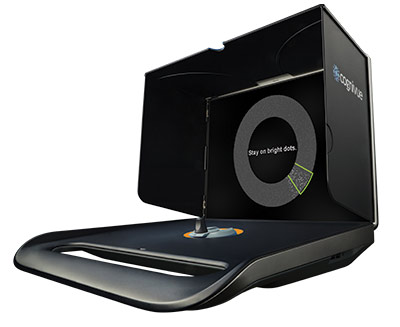
Cognivue Advanced performs a 10 minute test that assesses visuo-motor aptitude
OTHER ASPECTS OF SPORTS VISION
Even with all of this technology geared toward the assessment and enhancement of the visual system, however, eyecare professionals specializing in sports vision therapy often need to look beyond the eyes in the care they offer their patients. For Stewart, this has included nutrition counseling and post-competition visual recovery. There are several dietary supplements developed to improve visual health that are used by sports vision therapists, but understanding their proper—and safe—use requires education and research. The ISVA offers members a number of programs to assist in this regard.
“Every athlete has a goal they want to achieve,” notes Stewart, who served on the Worldwide Performance Vision Council, a group tasked with developing testing and training protocols for the 2020 Summer Olympics in Beijing. “Sports and performance vision offers an additional edge for patients, which ties in well to their skills training, strength and conditioning, nutrition and recovery.”
Andrich agrees that a “holistic” approach was vital in the practice of sports vision, given the diverse and unique needs of the patient base. “Our office offers vision training sessions for our sports vision patients along with comprehensive eyecare and nutrigenomic testing, which are recommendations for nutrition and supplements based on genetic testing,” he explains.
And of course, fitting athletes who req- uire vision correction with the appropriate solution—whether it’s eyeglasses, including for protective/safety, contact lenses or both—is vital. This means understanding of the sports applications for materials such as polycarbonate and Trivex, as well as the potential sports benefits of products such as polarized lenses, photochromics and certain tints and coatings.
“The optical benefit of this specialty is also very important,” Stewart says. “Every athlete should be wearing independently tested sports eyewear every time they step on the field, ice or court. It’s essential that we are protecting all of our patients, no matter their sport or age.”
Above all, eyecare professionals engaged in sports vision therapy say the specialty has helped them grow their overall practice—while adding a “fun” component, as Hamada put it—to their day-to-day work with patients.
“Specializing in sports vision implies high performance eyecare for the athlete, and we wanted to bring that impetus to every aspect of our office, from the time a patient steps into the office, until the moment they leave,” Hamada says. “It made us change what we did and what we said, from the pretest experience to the exam room, to vision correction and patient education, to the contact lenses we selected, and we transformed our optical with specialty eyewear and digitally enhanced lenses as well as lifestyle and performance tints. We recently branded our office decor and website to reflect our sports vision specialty. “I use the sports vision niche to promote and enhance the value of Surf City Optometry,” he continues. “Our sports vision expertise has helped us to grow and to thrive.” ■
Brian Dunleavy is editor of LabTalk magazine, a former 20/20 magazine editor and a lifelong sports fan.












